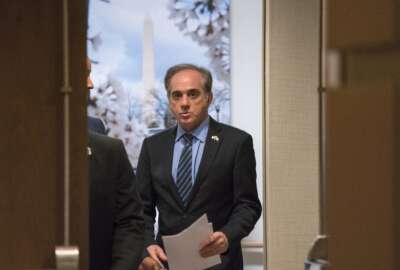

The Veterans Affairs Department says it's also eliminated 235 expired directives and 85 percent of outdated manuals in effort to cut red tape.
The Veterans Affairs Department says it’s cut positions at its central office in Washington, D.C. by 10 percent, while also consolidating mental health, primary care and geriatrics policy, and operations functions.
It’s part of the department’s efforts to eliminate bureaucracy and streamline decision-making — and remove itself from the Government Accountability Office’s biennial High-Risk List, VA announced Monday.
The agency said it recently submitted a comprehensive plan to GAO, which outlined VA’s efforts to address five specific risk areas when it added VA health care to the High-Risk List back in 2015.
The 10 percent figure makes sense, as former VA Secretary David Shulkin had kept a hiring freeze in place for senior positions at the department’s central office and required undersecretary approval for administrative positions at the Veterans Benefits Administration (VBA) and the Veterans Health Administration (VHA).
The department also closed the central office’s human resources function last year, as VA attempts to move more customer-facing positions out of Washington and to consolidated offices in the field.
And amid a troubling inspector general report about the department’s systematic failure to address problems at the D.C. medical center, Shulkin had called on the agency to develop a plan by May 1 to reorganize the central office.
In addition to VA’s efforts to cut unnecessary positions and functions from its central office, the department said its High-Risk removal plan includes four other broad areas:
To rid the agency of unnecessary red tape, for example, VA said it’s already eliminated 235 expired directives and 85 percent of outdated manuals.
VHA also stood up a new Office of Integrity to improve accountability, the department said. The new integrity office is consolidating its compliance, ethics and oversight programs into one, and it will also lead a governance committee to advise the VHA undersecretary on best practices for evaluating current operations.
Much of VA’s efforts to address its high-risk challenges stem from its reorganization plan.
Paul Lawrence, the president’s nominee to lead the Veterans Benefits Administration, helped an agency craft its official response last year to the administration’s reorganization executive order as a key principal at Kaiser Associates.
“This [experience] helped me enhance my perspective on driving change and collaborating with the Office of Management and Budget,” Lawrence told the Senate Veterans Affairs Committee at his nomination hearing last week. “What is differentiating about my experience as a consultant to the federal government is I’ve conducted extensive research into how government is managed by senior leaders.”
Lawrence said he’s collected best management practices from his interviews with senior agency leaders, and he plans to apply those lessons to the job at VBA.
He said one of those lessons will inform how he plans to manage his workforce: identify the root cause and a solution, spread that message to a large number of employees and reinforce the message with training.
Veterans service representatives use a specific manual to calculate a veteran’s benefit determination. The work is complex and often confusing, and VSRs have said it often takes at least two years to become truly proficient at the job.
“Leading the VBA can be a challenge, even for those who have the best skill set for managing a complex administration,” committee Ranking Member Jon Tester (D-Mont.) said. “Challenges such as leading the more than 23,000 personnel in the critically important division of the VA where morale has been a concern and firing folks cannot be one of the first instincts when dealing with employee matters.”
The American Federation of Government Employees (AFGE), which represents about 250,000 VA employees, is also concerned about those challenges. It wrote to the committee’s leadership about VBA’s “unreasonable and counterproductive performance standards,” which as Federal News Radio previously reported, is seriously impacting employee morale.
“These standards harm veterans by grossly valuing quantity over quality and do not accurately measure employee performance,” Thomas Kahn, AFGE director of legislative affairs, wrote in an April 10 letter. “These standards force employees to treat veterans like widgets instead of the warriors they are.”
The Senate committee is scheduled to vote on Lawrence’s nomination Wednesday.
If confirmed, VBA will have its first permanent undersecretary in nearly three years. Multiple top VA leadership positions have been vacant for hundreds of days. With the recent firing of Secretary David Shulkin, VA also lacks a permanent leader.
Senate VA Committee Chairman Johnny Isakson (R-Ga.) said last week he wants that to change as quickly as possible. The earliest his committee could hold Jackson’s nomination hearing is April 25, Isakson said, if the nominee quickly submits all vetting documents and answers questions for the record.
Copyright © 2025 Federal News Network. All rights reserved. This website is not intended for users located within the European Economic Area.
Nicole Ogrysko is a reporter for Federal News Network focusing on the federal workforce and federal pay and benefits.
Follow @nogryskoWFED

 Exclusive
Exclusive 